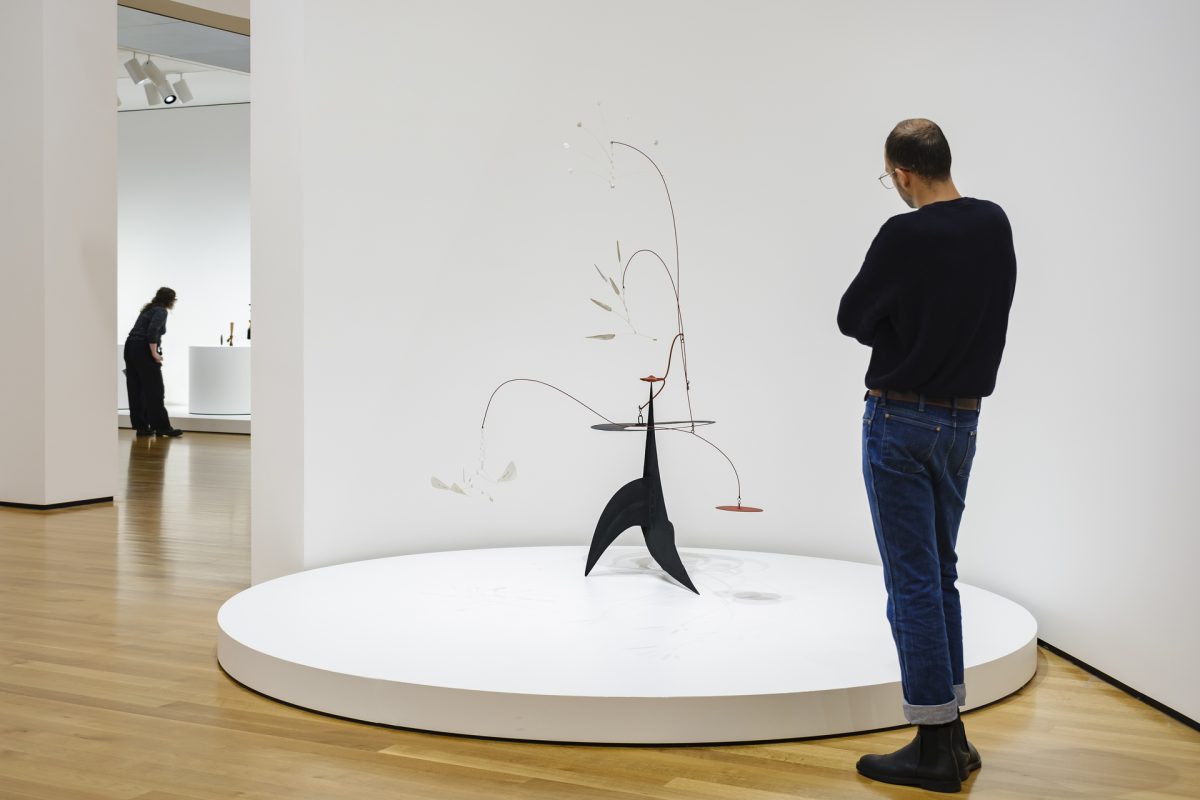Calder Smartphone Tour: Bougainvillier

In the late 1940s, Alexander Calder developed sophisticated sculptures with pierced elements and interchanging relationships, the largest and most resolved of which is Bougainvillier. The construction of this vibrant masterpiece includes three wispy tendrils with mobile bursts, the lowermost of which is suspended by a handmade chain. Although it derives its title from the French word for the bougainvillea plant, this work—the most elegant and commanding sculpture on view in Calder: In Motion, The Shirley Family Collection at SAM—is non-objective.
Calder’s choices for titles, whether in English or French, are not assets for artistic interpretation. He was known to intuitively name his sculptures after they were created, based on “some vague association,” as he said. “Sometimes it’s the whole thing that suggests a title to me, sometimes it’s just a detail.”
Bougainvillier made its public debut on the heels of Jean-Paul Sartre’s seminal 1946 essay, “Les Mobiles de Calder,” written by the French philosopher for the artist’s show at Galerie Louis Carré, Paris. Sartre’s words anticipated the complex environment created by a work like Bougainvillier, with its gestural lines projecting into unpredictable spaces:
“The forces at work are too numerous and complicated for any human mind, even that of their creator, to be able to foresee all their combinations. For each [mobile] Calder establishes a general fated course of movement, then abandons them to it: time, sun, heat, and wind will determine each particular dance. Thus the object is always midway between the servility of the statue and the independence of natural events.”
Calder Foundation President Alexander S. C. Rower shares more excerpts from Sartre’s essay in the tenth stop of the free smartphone tour of Calder: In Motion. Tune in now via our SoundCloud or by scanning the QR code next to Bougainvillier in the exhibition’s galleries.
Bougainvillier, 1947
NARRATOR: Bougainvillier is one of the works in the Shirley Collection most frequently requested for exhibitions. It dates from 1947, a period when Calder was focusing on standing mobiles. Calder Foundation President Sandy Rower:
ALEXANDER S. C. ROWER: The frilly lines, these wires that come out in space—even when they’re not active, you feel a tremendous sense of movement through space—are why he called it Bougainvillier. His process of titling, of course: it wasn’t that he saw a Bougainvillea vine with the beautiful purple leaves and blossoms. He made a sculpture and then, looking back in retrospect, said it’s kind of the tendrils of a line, I’ll call it Bougainvillier.
And the use of the title is not any kind of access into understanding or meaning of a work. You should really consider that the work has no meaning. But then you have to bring yourself forward and contribute and participate with the work in a way that the meaning is created. Calder always anticipated that the viewer was going to have an active role in not just experiencing his work, but in the viewer’s own interpretation.
NARRATOR: The year before Bougainvillier was made, the philosopher Jean-Paul Sartre explored these ideas in a seminal essay on Calder. Sartre captures the sense of what it’s like to experience a Calder sculpture. As he put it:
ALEXANDER S. C. ROWER: “Each of its twists and turns is an inspiration of the moment. In it you can discern the theme composed by its maker, but the mobile weaves a thousand variations on it. It is a little hot jazz tune, unique and ephemeral, like the sky, like the morning. If you miss it, it’s lost forever.”
– Lily Hansen, SAM Marketing Content Creator
Image: Installation view of Calder: In Motion, The Shirley Family Collection, Seattle Art Museum, 2023, © 2024 Calder Foundation, New York / Artists Rights Society (ARS), New York, photo: Alborz Kamalizad.